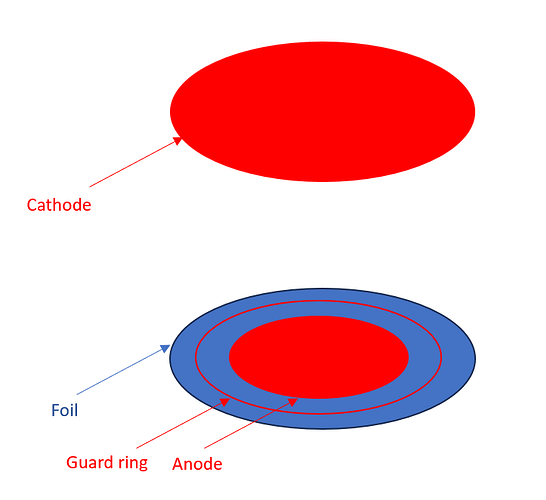Hi all, I’m trying to define a guard ring around a circular electrode using Garfield and nebem, and obviously i don’t understand something. I thought this was possible by defining a series of flat cylinders representing the different materials, something like that:
MediumConductor Cu;
MediumPlastic Kp;
Kp.SetDielectricConstant(4.0);
GeometrySimple geo;
…
SolidTube Insul1(0,0, 0,ChamberRadius,ElectrodeThickness/2);
Insul1.SetSectors(4);
SolidTube Guard(0,0, 0,ChamberRadius-0.1,ElectrodeThickness/2);
Guard.SetSectors(4);
SolidTube Insul2(0,0, 0,ChamberRadius-0.2,ElectrodeThickness/2);
Insul2.SetBottomLid(false);
Insul2.SetTopLid(false);
Insul2.SetSectors(4);
SolidTube Anode(0,0, 0,ChamberRadius-0.3,ElectrodeThickness/2);
Anode.SetSectors(4);
Anode.SetLabel(“s”); // set it as the electrode
// set potentials
Insul1.SetBoundaryDielectric();
Guard.SetBoundaryPotential(AnodeVoltage);
Insul2.SetBoundaryPotential(AnodeVoltage); // or SetBoundaryDielectric()? but does not make sense in contact of conductors…?
Anode.SetBoundaryPotential(AnodeVoltage);
// add components to the geometry
geo.AddSolid(&Insul1, &Kp);
geo.AddSolid(&Guard, &Cu);
geo.AddSolid(&Insul2, &Kp);
geo.AddSolid(&Anode, &Cu);
But it does not work at all: first nebem fails to initialize if all the elements have the same thicknesses, so i have to increase the inner ones. Also the field lines don’t “avoid” the kapton as I would expect. I guess I don’t understand how to set the boundary conditions between the dielectric and the conductor materials.
Thanks in advance for your help ![]()
